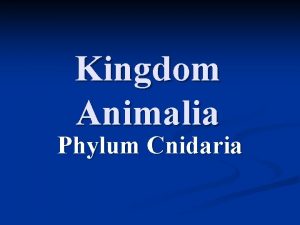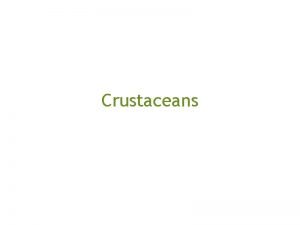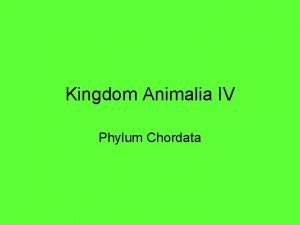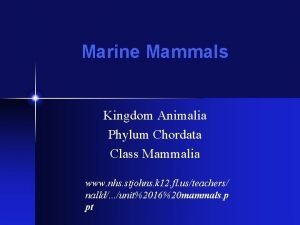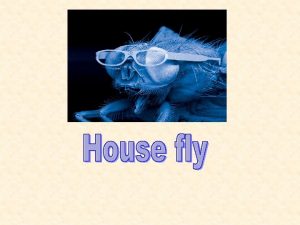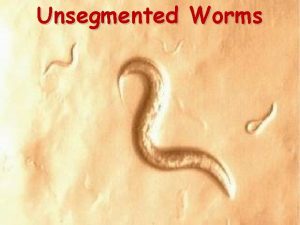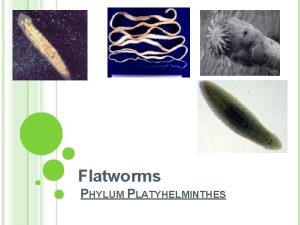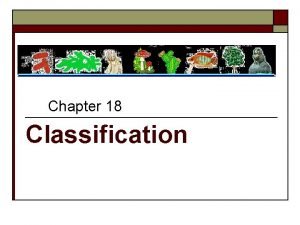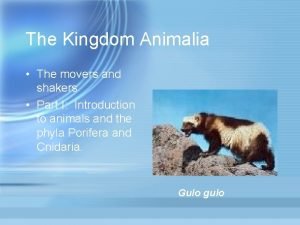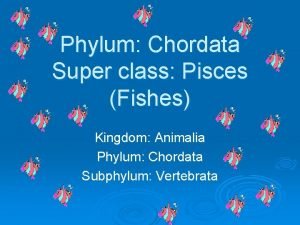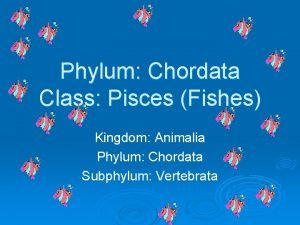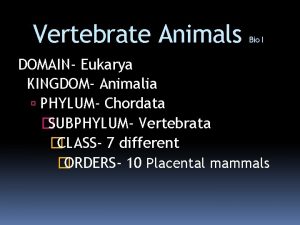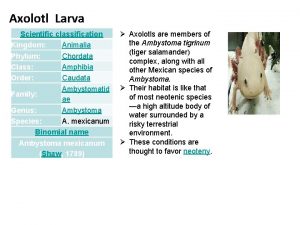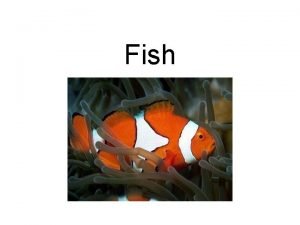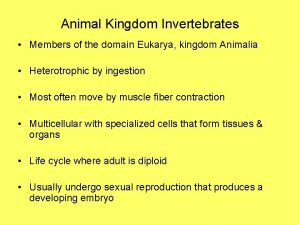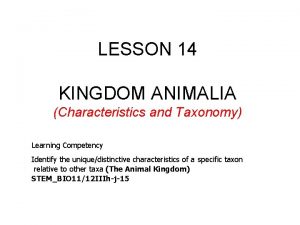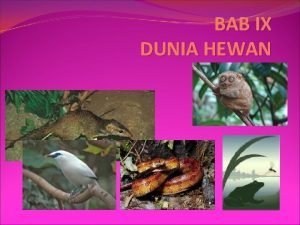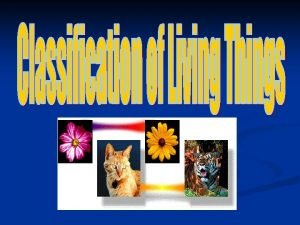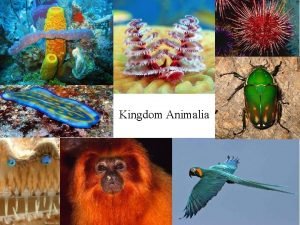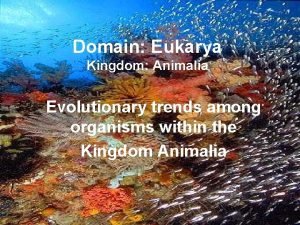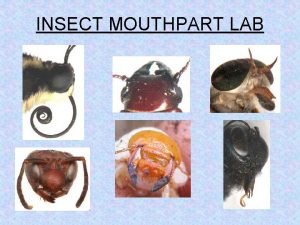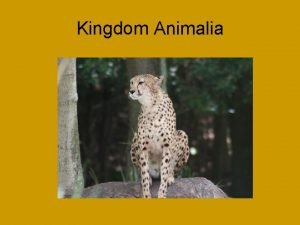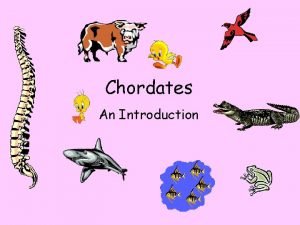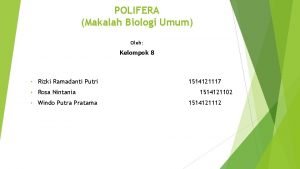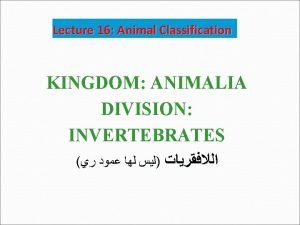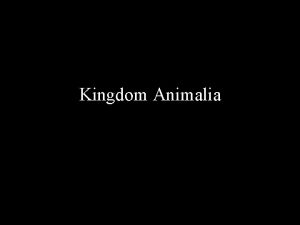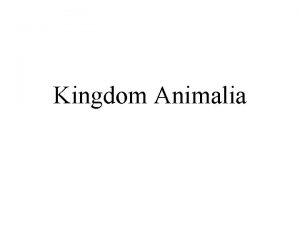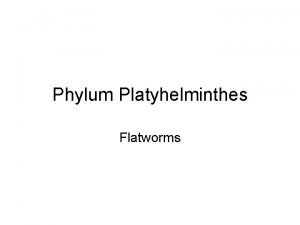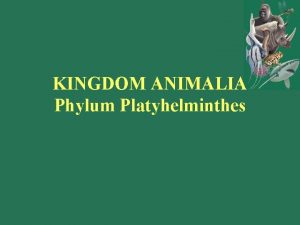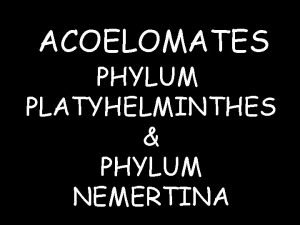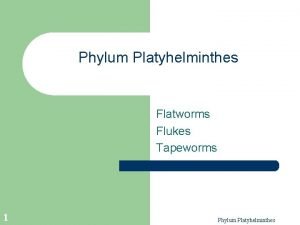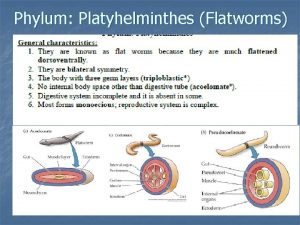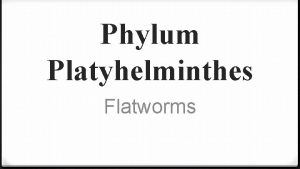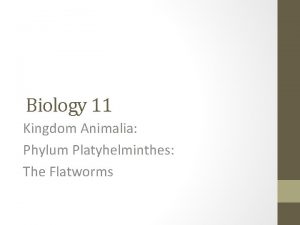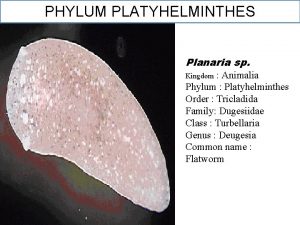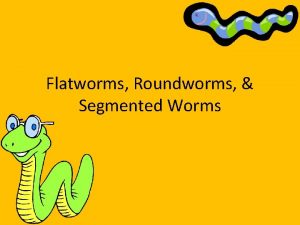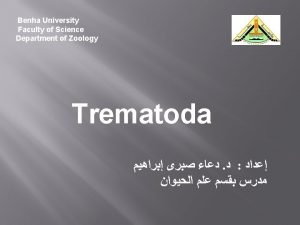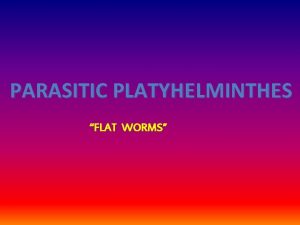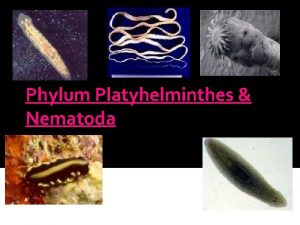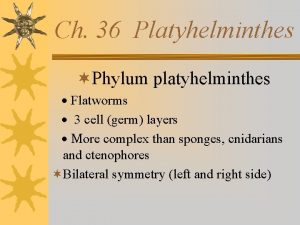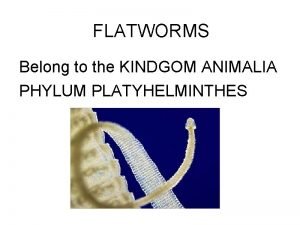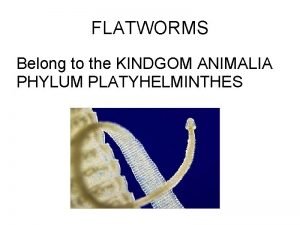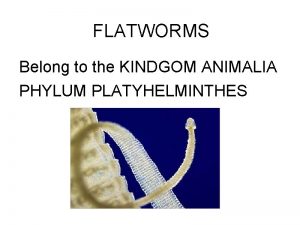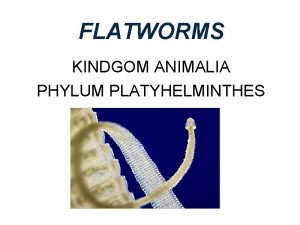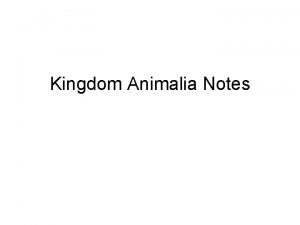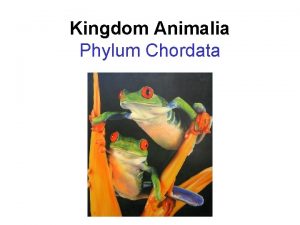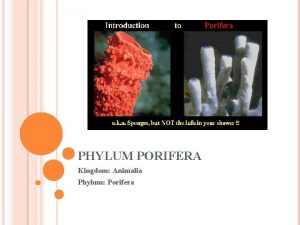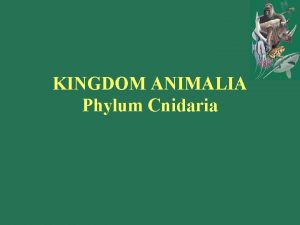FLATWORMS Kingdom Animalia Phylum Platyhelminthes The term Platyhelminthes








































- Slides: 40

FLATWORMS Kingdom Animalia Phylum Platyhelminthes

The term Platyhelminthes was first proposed by Gegenbaur (1859) for the flatworms. Gr. , platys-flat helmins- worm

Characteristics of Platyhelminthes Body symmetery: bilateral Body organization: triploblastic (3 layers) – Ectoderm – Mesoderm (first!!) – Endoderm Body Cavity: acoelomate








Animal Kingdom Acoelomate (no coelom) Pseudocoelomate Coelomate (false coelom) (true coelom) Porifera Aschelminthes Coelenterata Ctenophora Platyhelminthes Annelida Arthropoda Mollusca Echinodermata Hemichordata Chordata

Coelom Vs Haemocoel The key difference between coelom and haemocoel is that the coelom is the principal body cavity of annelids, echinoderms and chordates that originated from the mesothelium while haemocoel is the primary body cavity of arthropods and molluscs which is a reduced form of a coelom.

• Two body regions – Scolex – “head” • No cephalization • Hooks and suckers used to attach to inside wall of intestine – Proglottids • Body segments for reproduction

Characteristics continued • Digestive system: mouth & gastrovascular cavity • Reproduction: – Sexual: hermaphroditic – cross fertilization occurs between 2 worms – Asexual: fragmentation

Characteristics continued: • Circulation: diffusion • Nervous system: – Cephalization (first) & nerves – Eyespots, auricles, sensitive to light & chemicals • Respiration: diffusion through skin • Excretion: tubes open to outside, flame cells (rid of excess H 2 O)& mouth • Habitat: host (intestine) & freshwater


• Ecological roles: – Parasitic – Food source – Eat dead animals • saprophytes

Additional information: Free living ex) Planaria – freshwater Stores food as fat Brain coordinates movement & capable of learning its way through a maze Able to respond to light & chemicals

Additional information: Parasitic Ex) flukes and tapeworms • Lives in digestive tract & absorbs digested food from host so, NO digestive tract! • This leaves more room for reproduction – capable of producing 1, 000 s of eggs.

Platyhelminthes vs Cnidarians • Tissues organized into organs • No true organs – Reproductive system (organized organs) • Three embryonic tissue layers • Two Tissue layers – Mesoderm • Bilateral Symmetry • Cephalization and nerve cords • Radial Symmetry • Nerve Net

CLASSIFICATION

Class Cestoda: tapeworms > 3500 spp of endoparsites, almost all intestinal parasites with highly specialized body and life cycle. scolex 9 ft tapeworm from human host Largest in sperm whale was over 30 meters long

Class Cestoda • tapeworms • Tapeworms are parasites that live in the digestive system of vertebrate animals

Class Cestoda • • • Exclusive parasitic Body: dorso-ventrally flattened tape like Hooks and sucker are present Digestive system-absent Excretion: Protonephridia with flame cell Examples: Taenia spp ( tapeworm), Convoluta sp. , Echinobothrium sp.



Fun Facts About Tapeworms • Some tapeworms grow quite long. One species that parasitizes horses has been known to attain a length of 75 feet. • Ingesting tape worms for reducing weight is a diet routine: A rather surprising fact about tape worms is that ingesting them as a weight-loss technique is happening even in these modern times. The person undergoing this method has the direct risk of an infection. It also causes a dramatic reduction in the body’s ability to absorb nutrients; and a counter-effect, where the person eats more to balance the metabolic stress once the diet regime is over.


Fluke (liver, lung, heart, intestine) • Parasitic – Pharynx swallows host’s tissue and body fluids (including blood) – Common intermediate host: raw fish • No need for circulation or respiratory system – Live in tissues supplied by host’s blood – Absorb through gastrovascular cavity • Flame cells • Nerve cords and anterior ganglia – Do not have as specialized nerve cells like Planaria • Hermaphrodites – Complex life cycle with numerous larval stages that infect a number of hosts.

Class Trematoda • • Mostly parasitic Body: dorso-ventrally flattened leaf like Hooks and sucker are present Examples; Fasciola hepatica (Liverfluke), Diplozoon sp.


Class Turbellaria

Class Turbellaria • • Mostly Free-living fresh water organism Body: dorsoventrally flattened Hooks and sucker usually absent Examples: Planaria sp. , Bipalium sp. , Otoplana sp. , Notoplana sp.


Class Monogenea Dorsoventrally flattened body Ectoparasites Sucker is weak or absent Mouth lacks sucker Single host in life cycle, there is no intermediate host and the one egg gives rise to one adult worm, hence the name Monogenea. Example: Polystoma sp. , Diplozoon sp.

Flame Cell 1. 2. 3. 4. Cell Nucleus Bundle of Cilia (flame) Parenchyma Tissue Collecting Duct


Marine Flatworms

Flatworms are hermaphrodites When flatworms encounter each other, they engage in a 60 minute ‘dance’ during which they repeatedly strike at each other, both trying to inject their sperm under the skin of the other worm. The ‘winner’ becomes the male for that encounter, and the ‘loser’ must become the female & care for the fertilized eggs!

BLADDER WORM-Cysticercus sp. BLOOD FLUKES- Schistosoma sp. LIVER FLUKES- Opisthorchis sp. LUNG FLUKES- Paragonimus sp. DOG TAPEWORM- Echinococcus sp. BEEF TAPEWORM- Taenia saginata SHEEP TAPEWORM- Moniezia sp.
 Kingdom animalia phylum cnidaria
Kingdom animalia phylum cnidaria Kingdom animalia phylum arthropoda
Kingdom animalia phylum arthropoda What are chordates
What are chordates Coelenterata digestive system
Coelenterata digestive system Phylum chordata mammalia
Phylum chordata mammalia Seal phylum
Seal phylum Kingdom: animalia phylum: arthropoda class: insecta
Kingdom: animalia phylum: arthropoda class: insecta Mentohotep
Mentohotep Old kingdom middle kingdom new kingdom
Old kingdom middle kingdom new kingdom Nnn ruled
Nnn ruled Youtube egypt
Youtube egypt Pinworms and hookworms belong to the phylum
Pinworms and hookworms belong to the phylum Phylum annelida consists of unsegmented worms.
Phylum annelida consists of unsegmented worms. When classifying organisms orders are grouped together into
When classifying organisms orders are grouped together into Nine phyla of kingdom animalia
Nine phyla of kingdom animalia Kingdom pisces
Kingdom pisces Domain eukarya, kingdom animalia (or animal)
Domain eukarya, kingdom animalia (or animal) Kingdom animalia phylums and classes
Kingdom animalia phylums and classes All vertebrate animals are in domain
All vertebrate animals are in domain Classification of axolotl larva
Classification of axolotl larva Fish gill
Fish gill Domain eukarya kingdom animalia
Domain eukarya kingdom animalia Mammals characteristics
Mammals characteristics Siklus obelia sp
Siklus obelia sp Kingdom animalia cell structure
Kingdom animalia cell structure Kingdom animalia organisms
Kingdom animalia organisms Insects kingdom
Insects kingdom Monera, protista, fungi, plantae animalia
Monera, protista, fungi, plantae animalia Coelom
Coelom Cladogram animal kingdom
Cladogram animal kingdom Protista prokaryotic
Protista prokaryotic Cladogram of the 6 kingdoms
Cladogram of the 6 kingdoms Kubung merupakan hewan bersayap kulit termasuk ordo
Kubung merupakan hewan bersayap kulit termasuk ordo Animalia kingdom
Animalia kingdom Kingdom animalia contains 350 000 species of what
Kingdom animalia contains 350 000 species of what Osteichtheyes
Osteichtheyes Animalia kingdom chordates and vertebrates
Animalia kingdom chordates and vertebrates Manfaat calcarea
Manfaat calcarea Kingdom animalia
Kingdom animalia Automorphic trait
Automorphic trait Animalia kingdom characteristics
Animalia kingdom characteristics
